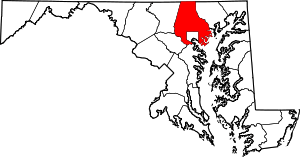Baltimore County Police Department
| Baltimore County Police Department | |
|---|---|
| Abbreviation | BCOPD |
|
Patch of the Baltimore County Police Department | |
|
Seal of Baltimore County, Maryland | |
|
Flag of Baltimore County, Maryland | |
| Agency overview | |
| Formed | 1874 |
| Employees | 2492 |
| Legal personality | Governmental: Government agency |
| Jurisdictional structure | |
| Operations jurisdiction* | State of Maryland, United States |
 | |
| Map of Baltimore County Police Department's jurisdiction. | |
| Size | 612 mi |
| Population | 817,455 (2013) |
| General nature | |
| Operational structure | |
| Headquarters |
Public Safety Building, 700 East Joppa Road Towson, Maryland 21286 39°24′0.6″N 76°35′23″W / 39.400167°N 76.58972°W |
| Officers | 1,824 |
| Unsworn members | 244 |
| Agency executive | James Johnson, Chief of Police |
| Facilities | |
| Precincts |
10
|
| Detention Centers | 1 |
| Automobiles | 860 |
| Boats | 3 |
| Helicopter Eurocopter AS350s | 3 |
| Dogs | 28 |
| Website | |
| Official Website | |
| Footnotes | |
| * Divisional agency: Division of the country, over which the agency has usual operational jurisdiction. | |
The Baltimore County Police Department is the primary law enforcement agency for Baltimore County, Maryland. They have been accredited by Commission on Accreditation for Law Enforcement Agencies (C.A.L.E.A.) since 1984.
Police chief
The current Chief of the county police department is James Johnson. Chief Johnson took over as Chief on May 31, 2007, Chief James Johnson's formal ceremony was held that July when Maryland Governor Martin O'Malley named Chief Terrence B. Sheridan as the new Superintendent of the Maryland State Police.
Then Baltimore County Executive, James T. Smith, Jr. nominated Johnson for the position of Police Chief upon the exit of Sheridan. Johnson was subsequently approved by the County Council. Chief James Johnson has held every sworn rank in the Baltimore County Police Department, and started his career as a cadet at the age of 18; he has a 30 plus years with the department.
Milestones
1874: The Baltimore County Police Department was established by the General Assembly of Maryland on April 11, 1874. The Maryland state legislature approved what became Chapter 374 of the Laws of Maryland. This authorized the Board of County Commissioners for Baltimore County "to appoint such number of policemen as they may deem necessary, for the better protection of persons and property; the number not to exceed thirty at any one time, and to designate such number of said policemen as they may deem advisable, not exceeding five, as chief policemen."
A second provision stated that "the pay of each policeman shall be two dollars per day, except such police as may be mounted; and mounted policemen shall furnish their own horses, trappings, equipments and forage for horses, and the pay of the mounted policemen shall be three dollars per day." On June 17, 1874, the County Commissioners divided the two mile (3 km) portion of the county bordering the Baltimore City boundary into five districts and appointed the first police force. Officers were appointed to one year terms.
1878: County Commissioners were authorized to build a station house at Waverly. The Canton Station was added a year later. Both communities were absorbed into the adjacent City of Baltimore, the first at the second major annexation of 1888 and the second in the third annexation of 1919
1883: In 1883 a new position was created, "Marshal of Police", (a title then also used on the city force, the Baltimore City Police Department since its reorganization and supervision by the Governor of Maryland in 1860). Charles O. Kemp was appointed to this office. Kemp, a loyal Democrat, had been the Superintendent of the Baltimore County Almshouse, (now the site of the Historical Society of Baltimore County). He had served as a trustee for one of the schools in the Fifth District. The new position consolidated the responsibility and control of the police force under one person instead of individual chiefs for each police district.
1885: The first call boxes were installed in the area around Huntington Avenue (later renamed 25th Street) in the Harwood neighborhood, south of Waverly, North Avenue, (then also known as Boundary Avenue - the former city limits of 1816-1888), near Jones Falls, and 28th Street (also in Waverly, off Greenmount Avenue/York Road).
1886: A new station was built in Mount Winans, (also now in the southwest portion of the City since 1919).
1888: A 17-square-mile (44 km2) portion of Baltimore County was annexed by Baltimore City. The number of officers in the Baltimore County Police Department was cut from 33 to 10 as officers and station houses were absorbed into the Baltimore City Police Department (originally organized as a nightwatch and constables in 1784, reorganized under supervision of the Governor of Maryland in 1860) on the western and northern "precincts" adjacent to the City. The heavily industrial and residential communities on the east such as Highlandtown and Canton voted against annexation in the referendum and stayed in the County until 1919.
1891: B.Co.P.D. Stations were built at Govans and Arlington.
1892: The Mount Washington Station opened.
1894: Terrence Doyle became the first county police officer to be shot when he attempted to arrest two men for breaking into a barn. Doyle was shot six times, but none of the wounds proved serious and he recovered. The two suspects were apprehended.
1902: The Maryland General Assembly passed an act aimed at improving the background of those appointed to the Baltimore County police force. The act stated: "all appointments hereafter made to the police force of Baltimore County shall be made from the qualified voters thereof, and all applications for such appointments shall be made upon printed blanks to be furnished free of charge by the County Commissioners, wherein the applicant shall set forth in his own handwriting his full name and age, the place and State of his birth, his occupation for two years preceding his application, and such other information as the Commissioners may require touching the merit and fitness of the applicant for the position for which he applies; such application shall be signed by the applicant, with his affidavit that the facts therein set forth are true to the best of his knowledge and belief, and shall contain blanks to be filled in by four reputable citizens of said County, certifying that the applicant is known to them for not less than one year and in character and habits, to the best of their knowledge and belief is in all respects fit for service which he wishes to enter. All appointments shall be hereafter made from applications filed not less than one month or more than two years previous to such appointments; such appointee shall not be less than 21 years nor more than 45 years of age; all officers shall be retired from service at an age not exceeding 58 years."
1903: Invented in 1876 by Alexander Graham Bell and installation began in the City two years later with the organization of the Maryland Telephone Company. Telephones were placed in the Arlington, Mount Winans, and Canton police stations. County Commissioners approved the purchase of a patrol wagon not to exceed the cost $265.
1912: Officers were granted twelve days of leave per year. Prior to this, officers were on duty seven days a week.
1913: The first female was appointed to the county police force as a matron. Two other women, Eva Aldridge and Ruth Jones were appointed to summer positions as Special Officers to protect young girls at the river resorts along the Patapsco River, Back River and Middle River in the eastern part of the county along the Chesapeake Bay.
1916: The first patrol automobile was purchased and the first motorcycle was also put into service.
1919: Another 40 square miles (100 km2) of suburban and rural Baltimore County was annexed by Baltimore City in the third major annexation after a long political campaign since 1914, cresting in 1918 in the state legislature voting. Baltimore County loses this time 34 of its 43 officers to the Baltimore City Police Department. The Canton, Arlington, Mount Winans, and Gardenville stations also became part of the city forces as of January 1, 1919.
1920: New County stations in the reduced territories/jurisdictions were built in Pikesville, Halethorpe, Dundalk, Essex, and Fullerton.
1927: A new Baltimore County Police Headquarters was built on Washington Avenue opposite the Baltimore County Courthouse in the county seat of Towson, Limestone blocks from the Ridgley estate at Hampton and similar architecture to the 1855 Courthouse is used. The Bureau of Identification was established. Its main purpose was to classify fingerprints and photographs and to serve as an aid in solving crime, a scientific process now being championed by the newly emergent Federal Bureau of Investigation (F.B.I.).
1928: Catonsville Station was built.
1932: A Turnkey at the Pikesville Station was killed by an escaping prisoner. William Hunter, who was 74 at the time, was shot by one of the two prisoners who escaped. Both prisoners were later recaptured.
1939: Applicants were required to pass a written test before being hired as a Baltimore County Police Officer. A one-week training program was established.
1940: A plain clothes unit was established and trained to handle criminal investigations.
1941: A police training academy for the county opened in Towson.
1942: A two way radio system was installed.
1943: The Edgemere Station was built adjacent to a fire station on old North Point Road.
1945: Teletype machines were installed.
1947: A fire at the Towson Station killed two prisoners being held in the lockup despite efforts by officers to pull the bars out of the windows using a tow truck.
1949: The pistol practice range was opened in Texas, Maryland (south of Cockeysville), next to the old historical County Almshouse on Van Buren Lane (now the Historical Society of Baltimore County). Baltimore County motorcycles became the first in the state to be equipped with two-way radios.
1951: The Training Division was formed.
1952: The Traffic Division was formed. First black/Afro-American patrol officers on the County force are appointed: Armond Elliott, Frances Jackson, and James Johnson.
1954: Virginia Weed and Leah Perry became the first two women to be appointed to the Juvenile Protection Bureau with the rank of Sergeant. Parkville Station was opened.
1955: The new Woodlawn Station opened replacing the previous 20-year-old sub-station.
1957: The Accident Investigation Unit was created. The first departmental manual was distributed.
1958: A mandatory police promotional test was instituted. The first polygraph ("lie detector") machine was purchased.
1960: Cadet program for training initial officers instituted
1961: A new Headquarters building opens on Kenilworth Drive. The K-9 Unit of search and patrol dogs was formed.
1962: A new larger modern station on Wilkens Avenue (adjacent to the future suburban campus of the University of Maryland Baltimore County [U.M.B.C.] established in 1966) replaces the two previous Halethorpe and Catonsville stations.
1965: Garrison Station opens on Reisterstown Road.
1966: A new pistol range opens on Dulaney Valley Road.
1969: The new Cockeysville Station opens on Wight Avenue.
1972: The Tactical Division was formed.
1973: A new Essex station was built. The Fraternal Order of Police union and fellowship lodge was established.
1974: Precinct 11 Essex creates first mariachi band in county history shortly followed by PC-12 North Point.
1975: The Marine Unit was established.
1976: First female officer promoted to the rank of Major.
1978: Hostage Negotiations Team was created.
1979: Baltimore County Police Foundation was formed.
1981: First black officer promoted to the rank of Lieutenant.
1983: The Police-Community Relations Council was established.
1984: Baltimore County officer designs the "McGruff Crime Prevention" stamp. Maryland's first Child Abuse Unit was established in Baltimore County. The B.Co.P.D. became the first major department in the country to be awarded national accreditation.
1985: North Point Station opened on Wise Avenue.
1987: White Marsh Precinct opened replacing the Fullerton Station (future stations are designated as "Precincts").
1990: The first helicopter was placed into service.
1991: The new Woodlawn Precinct opened replacing the one built in 1955.
1993: The Citizen's Police Academy was developed.
1995: First black officer promoted to the rank of Colonel. First female officer promoted to the rank of Colonel.
1996: The new Police Memorial was dedicated on the Court House Plaza located on the south side (joining a similar structured monument for the Baltimore County Fire Department) between the old historic Baltimore County Circuit Courthouse in Towson (along Washington Avenue between West Chesapeake and West Pennsylvania Avenues), [built 1854, annexes 1910, 1925, 1958] and further to the west is the newer County Courts Building of 1971. Later plaza between the two on the former bed of Baltimore Avenue is renamed "Patriots Plaza".
2001: The new Towson Precinct opened replacing the earlier station built in 1927.
2002: Construction of new PAL centers means that, for the first time, there is a center in every precinct. The Department joins the CODIS database allowing it to share and access DNA information to identify suspects. The agency is re-accredited by the Commission on Accreditation of Law Enforcement Agencies (CALEA). The computer crime unit and its mission are expanded and it is renamed the Digital and Multimedia Evidence Unit.
2003: Precinct 8: Parkville is restored as an independent command.
2004: Randallstown sub-station is opened.
2005: A Police substation is opened as part of the Stembridge Community Center in Precinct 11: Essex.
2006: The Gang Enforcement Team is created to fight growth of gangs in the County.
A new station is opened for Precinct 4: Pikesville.
Precinct 3's name is changed from Garrison to Franklin.
2007: The Violent Crime Unit is created to investigate non-fatal shootings and other serious assaults.
Three new helicopters are acquired.
A new station is opened for Precinct 8: Parkville.
2015: The North Point Precinct is renamed as the Dundalk Precinct, officials believed the name better fit the area.
2016: The new Dundalk Precinct nears completion at 428 Westham Way, site of the former Baltimore County Public Schools Eastwood Center.
Precincts
Formerly known as "police stations", since the 1970s Baltimore County has been divided into ten police precincts. Number 5 is intentionally skipped and will be used if the department needs to expand at a later time. Most recently, this happened in 2006 when Precinct 4 opened in Pikesville and Precinct 3 moved from Garrison to Franklin. Former Precincts 10 (Fullerton) and 13 (Edgemere) were absorbed into Precincts 9 and 12, respectively.
- Precinct 1 - Wilkens (Arbutus, Baltimore Highlands, Catonsville area)
- Precinct 2 - Woodlawn
- Precinct 3 - Franklin (Owings, Mills, (Reisterstown area)
- Precinct 4 - Pikesville
- Precinct 6 - Towson
- Precinct 7 - Cockeysville
- Precinct 8 - Parkville
- Precinct 9 - White Marsh
- Precinct 11 - Essex
- Precinct 12 - Dundalk
Demographics
- Male: 87%
- Female: 13%
- White: 88%
- African-American/Black: 10%
- Hispanic: 1%
- Asian: 1% [1]
Fleet
The primary patrol vehicle used is the Ford Crown Victoria. Both Dodge and Chevrolet vans are used for prisoner transport. Motorcycle units ride Harley-Davidson Road Kings. The department recently placed 3 new Eurocopter AS350B3 helicopters into service.
In early 2014, the department announced that they would begin to phase out the aging & discontinued Ford Crown Victoria with new Ford Taurus police interceptors.
Weapons
The primary duty firearms issued are the FNS-40LS[2] .40 caliber pistol, Remington 870 shotgun, Tasers, and Less Lethal beanbag shotguns. M16 patrol rifles are issued to some specifically trained officers. All officers are issued OC spray and an ASP baton.
Rank structure and insignia
The Baltimore County Police Department rank structure is as listed:
| Rank | Insignia |
|---|---|
| Chief Of Police | |
| Colonel | |
| Major |  |
| Captain |  |
| Lieutenant | |
| Sergeant |  |
| Corporal |  |
| Police Officer First Class |  |
| Police Officer | |
See also
References
- ↑ Law Enforcement Management and Administrative Statistics, 2000: Data for Individual State and Local Agencies with 100 or More Officers Archived September 27, 2006, at the Wayback Machine.
- ↑ Slowik, Max. "Baltimore County PD picks FNS-40LS for duty". guns.com. Retrieved 21 January 2015.



.svg.png)